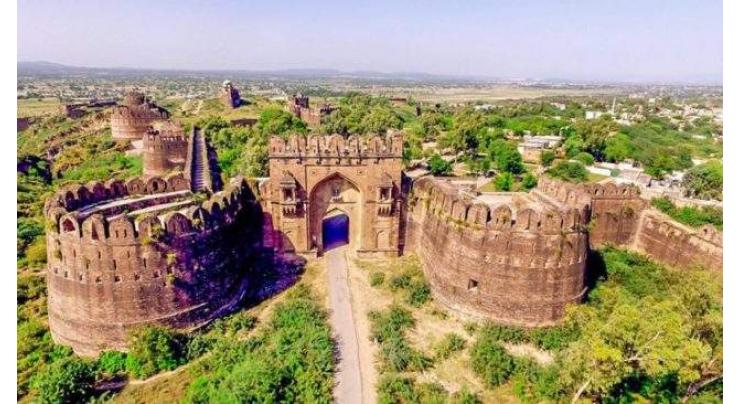ISLAMABAD: Relative to Jhelum, Rohtas Fort, with its distinctive architecture and four kilometers of circumference, was formerly thought to be the largest military installation in South Asia.
From 1541 to 1548, the Fort’s construction took about seven years to finish. The tall and dense walls of Rohtas, which are renowned for their distinctive fundamental architecture, are reminiscent of Afghan and Mughal highlights as well as Turkish art and culture.
Later, Mughal Emperors lived in the fort that Sher Shah Suri (Farid Khan) had constructed. Its vast expanse spans seventy hectares, featuring twelve colossal gates and sixty-eight bastions that still tell the narrative of its past. Six enormous weapon storage cells are present.
The Mehar un Nisa mausoleum gives its location even greater grandeur. Because of Rohtas’ significance in history, the United Nations Educational, Scientific, and Cultural Organization (NESCO) listed it as a World Heritage Site in 1997. The Shahi mosque, located close to Kabul Gate, is unique in that it lacks pillars and a minaret.
Sheesh Mehal speaks for the architectural grandeur of ancient art and customs. According to the history, it is one of the longest used military bases from 16th century till the days of Durranis and Sikhs of 19th century.
However, in addition to disturbing the area, the illegal encroachments have damaged the Fort’s reputation as a whole. As a World Heritage Site that significantly contributes to the nation’s history, Rohtas requires urgent restoration and conservation. Similar to other nations, Pakistan ought to establish appropriate protocols for conserving its rich past, as it can significantly contribute to enhancing the nation’s reputation.
Once known as the “white shining egg,” Sanskrit is currently experiencing flooding due to government incompetence. The Fort’s roofs are covered in green grass and red bricks that have weathered from their former magnificence. The Rohtas Fort ought to be safeguarded in accordance with antiquity.
According to Muhammad Ayub, the local guide, the government started a project in 2005 in partnership with US-Aid, but it was never finished because of changes in government policies and the 18th Amendment. He claimed that the shift in authority from the federal to the provincial levels had not resulted in any improvements. However, he stated that the Punjab government had approved around 140 million in preservation money for the Rohtas between 2013 and 2018.
According to Habib, a local, the Fort has been a part of the populous region around since its erection. Locals from the surrounding area helped with Rohtas’ development.
On February 19, 2018, UNESCO and the Punjabi government inked a historic $2.8 million agreement under the Punjab Tourism for Economic Growth Project (PTEGP) for the “Protection and Promotion of Cultural Heritage of Punjab for Sustainable Tourism and Economic Growth.” The World Bank provided financial support for this project.
The project’s goal was to support the efficient administration of tourism to cultural and religious heritage sites in accordance with UNESCO’s mission. Raising cultural awareness and respect for variety while putting into practice efficient plans and policies for the management of cultural heritage and tourism through institutional reform is the overarching objective, which aims to promote tolerance and peace.
“In addition to creating site management plans, the project takes a community-centered approach within the framework of the project through capacity-building of communities surrounding the sites,” stated Malik Nadeem Kamran, Minister of Planning and Development for Punjab. He claimed that by using education, the project would support the promotion of respect for cultural variety. He said that important players in the religious communities provided training to the present custodians of the sites to support them in upholding the sanctity and religious significance of the locations.





